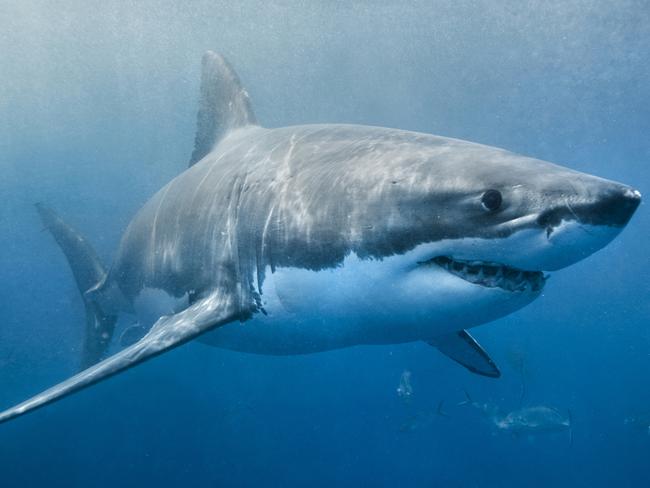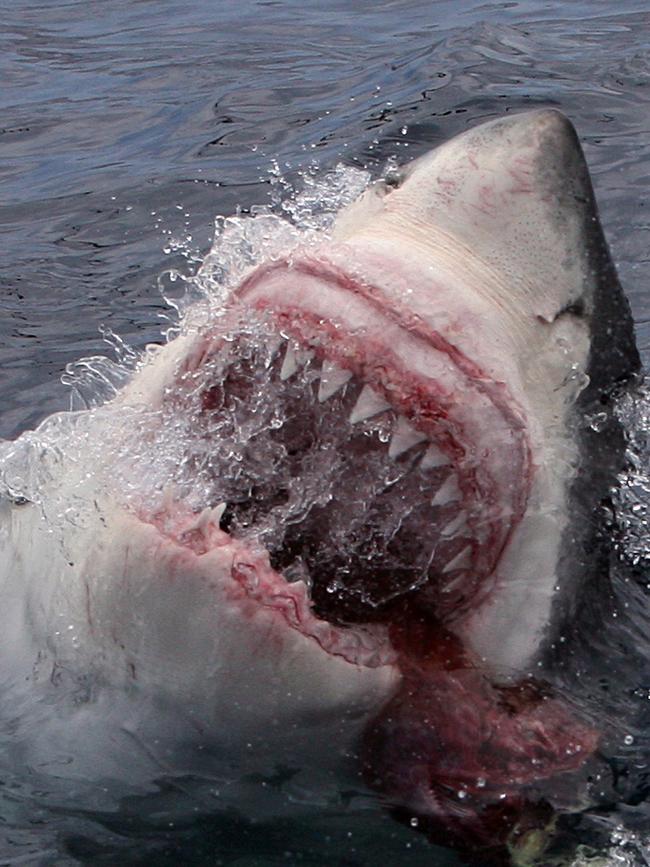Shark myths debunked: Expert reveals the best way to survive an attack
MICK Fanning may have pulled off a miraculous escape from a great white shark with a volley of scrappy punches, but going the biffo with the fearsome predator is actually a no-no.

NSW
Don't miss out on the headlines from NSW. Followed categories will be added to My News.
SURFING legend Mick Fanning may have pulled off a miraculous escape from a great white shark with a volley of scrappy punches but going the biffo with the fearsome ocean predator is not your best form of defence.
Marine biologist Blake Chapman says the best way to stave off a shark attack is actually to gouge its eyeballs out or get a hand under its gill flaps and “tear, squeeze, do whatever you can”.
The University of Queensland researcher has penned a new book, Shark Attacks: Myths, Misunderstandings and Human Fear, to tackle some of the false information that surrounds the shark.

She explains that contrary to the popular belief that a jab in a shark’s nose is the best way to break free from an attack, it will more than likely be ineffective, particularly as landing a crushing blow against the drag resistance of water is extremely difficult in any case.
“These are big, powerful animals with extremely rough and tough skin so punch them if you can but if you miss their nose your hand is in serious trouble,” she said.
“In reality, humans are largely defenceless in the water, where sharks are very apt and highly-evolved predators. You need to prove yourself to be a formidable opponent not worth the risk and energy expenditure the shark would need to exert to continue to pursue you.”
Ms Chapman said she was lukewarm on shark-repellent gadgets advertised as being able to increase the chance of survival by emitting electrical currents, saying “nothing is failsafe”, especially when a lot of devices have an effective range of just 80 centimetres.
“Sharks are large predators designed to take down serious prey; at that close range it’s already attacking,” she said.

And the researcher was just as sceptical about mesh nets that don’t isolate entire beaches, typically spanning just 150 metres in NSW at just six metres high in 10-14 metres of water.
Close to 40 per cent of sharks caught in Australian nets are trapped “beachside”, meaning they had already cruised around the shallows and were on their way back out to ocean, according to research quoted in the book.
Her advice comes after a suspected shark attack at a popular beach near Port Stephens on Saturday morning.
A 30-year-old surfer swam in to Biruri Beach, where an off-duty nurse attempted to stem blood coming from his right foot until ambulances arrived to take him to John Hunter Hospital. He remains in a stable condition.
The beach was closed for three hours while council lifeguards on jet skis searched in vain for the shark.
A Department of Primary Industries biologist will analyse photos of the bite marks to identify the type of shark.
Ms Chapman said swimmers who manage to escape the jaws of the beast, like Hawaiian Tony Lee who wrestled free from a tiger shark off the island of Oahu two years ago, must resort to desperate tactics.
He eventually swam to freedom clutching the shark’s eye in his hand, after initially wasting time punching the shark’s well-protected snout.
“He didn’t see the shark until his leg broke and he could literally spin around,” Ms Chapman said.
“Amazingly, people who’ve been in these situations have a calm sense come over them and Tony knew from surfing to take big breath in for when shark dragged him under, which is when he ripped the shark’s eye out.”
Unprovoked sharks have attacked an average of 14 swimmers, surfers and divers along Australia’s coastline every year for the last decade, accounting for an average of 1.5 deaths a year.
The last two El Nino years, 2009 and 2015, saw the number of attacks climb to 22 and 18 respectively, as warmer water and shifting currents brought migratory sharks into contact the same waters as humans.
Australia regularly ranks second in the world for shark bites, behind America and ahead of South Africa.
Swimmers can lessen the likelihood of losing chunks of flesh by refusing to swim near schools of bait fish, at dawn and dusk when visibility is low, or far off the coast where sharks roam.
The book dispels a host of shark survival myths, like the misnomer dolphins in the water signal sharks have cleared off. Sharks regularly feed on the same fish dolphins fancy and will eat dolphins too.

SHARK MYTHS
MYTH: The best way to escape a shark’s grip is to punch it in its sensitive nose.
Not true: Shark snouts are well protected with thick skin, which means a punch won’t do much damage or dissuade an attack. Ripping and tearing at the sharks gills, where there is high blood flow, is a better tactic. But the best course of action is to gouge or rip out its sensitive eyes.
MYTH: All sharks are man-eaters.

Not True: There are 509 species of sharks in the world but only 26 have been definitively recorded biting people. The bad news is, all 10 of the species that have caused fatal unprovoked bites on humans can be found in Australian waters.
MYTH: Shark nets keep swimmers safe from attacks.
Not True: 40 per cent of sharks caught in Australian nets were swimming from the beach back out to sea. Shark nets do not completely protect shallow water from ocean predators. Net lengths range from 150 metres in NSW to 186 metres in Queensland. They are typically six metres high, but float in 10-14 metres of water.
MYTH: Electromagnetic fields deter shark attacks
Plausible: Surfers, spearfishers and divers strap devices to their boards, wrists or ankles in the hope electromagnetic fields or high frequency signals will ward off attacks. Very few products have been rigorously scientifically tested and despite manufacturer’s big budget advertising pitches, all have limitations.
MYTH: Sharks see swimmers as easy and satisfying meals
Not True: Unlike monster saltie crocs in the top end, sharks rarely devour swimmers. Bodies are almost always recovered, even after fatal bites. Even inquisitive shark bites can tear off huge chunks of human flesh because of their lethal teeth, but people are very rarely eaten whole.
